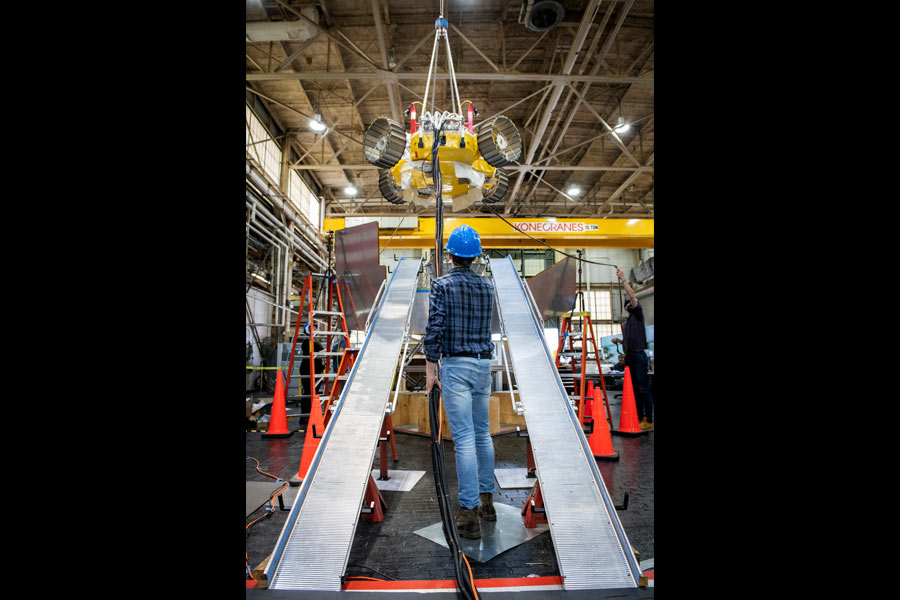NASA will spend about $800 million not to send a robotic rover to the moon.
The rover, known as the Volatiles Investigating Polar Exploration Rover, or VIPER, is already built. The launch is still scheduled to take place late next year, but VIPER will not be aboard.
The space agency announced Wednesday that it planned to cancel the mission and that it planned to disassemble VIPER, a wheeled vehicle about the size of a small car, which was to search for water ice in the shadows near the moon’s south pole. A nonfunctional “mass simulator” will take its place.
The reconnaissance had been intended to provide insights about what lies in eternally dim craters in the polar regions before NASA astronauts land there in the coming years. However, delays with both the VIPER rover and the privately built spacecraft that was to have landed the rover on the moon’s surface led to uncertainty about the mission’s timeline. The rising costs risked cuts or cancellations to other missions.
“Decisions like we’ve been discussing today are extremely difficult to make,” Nicola Fox, associate administrator for NASA’s science mission directorate, said during a news conference. “We don’t make them lightly. We put a lot of thought into the best way to move forward.”
The proposed VIPER cancellation is the latest setback in NASA’s science efforts.
Costs for a mission to collect rocks and soil from Mars and bring them to Earth for study have spiraled upward, leading NASA to ask for new, cheaper ideas for how to accomplish the task. The Europa Clipper, a robotic mission that is set to study a moon of Jupiter with an under-ice ocean, may be delayed because of problems with some of its electronic components.
NASA missions often end up costing more and taking longer than intended, and the agency still sometimes proceeds, pushing back other missions. But with NASA unlikely to receive significant budget increases from Congress in coming years, agency officials decided it was better to cut their losses with VIPER.
Through June, NASA had spent $450 million on VIPER, which is already fully assembled with its science instruments installed, said Joel Kearns, deputy associate administrator for exploration in the science directorate. However, testing of the rover to make sure it would survive the shaking of a rocket launch and the harsh conditions of space has not been completed.
The cancellation would save at least $84 million, as NASA would no longer need to pay to complete the tests or to operate the rover on the moon, Kearns said. Other missions will be able to achieve many of VIPER’s goals, although not as quickly, Fox said.
NASA is planning to disassemble VIPER and use the instruments and other components on the other missions. However, NASA said it was willing to listen to proposals from American companies or international partners for using the VIPER system as is, as long as there would be no additional cost to the federal government.
In addition to the costs of building the rover, NASA hired Astrobotic Technology of Pittsburgh to take VIPER to the moon. The agency is still planning to pay Astrobotic $323 million to proceed with that mission.
Even without the rover and its scientific instruments, a successful demonstration of the lander, named Griffin, would still be valuable, Kearns said.
VIPER was originally scheduled to launch in late 2023. NASA then asked Astrobotic to perform additional testing on Griffin, pushing the launch date to late this year. But because of lingering disruptions of the manufacturing supply chain in the aftermath of the COVID-19 pandemic and other factors, VIPER and Griffin would not have been ready for launch until September next year at the earliest.
Fox said NASA was also worried that the mission would not be ready even then, and additional delays would further add to the price tag. Kearns said NASA had decided not to replace VIPER with other scientific payloads because those changes would require renegotiation of the fixed-price contract with Astrobotic.
Astrobotic’s first lunar mission for NASA, sending a lander named Peregrine in January, failed soon after launch and never got close to the moon. Other moon landers this year have been more successful, including one from another American company working for NASA, Intuitive Machines, which reached the lunar surface in February, although it tipped over.
Kearns said Astrobotic was free to sell space on Griffin to other customers.
“If they want to fly more commercial payloads, we can make our mass simulator smaller so that the total mass is the same,” he said.
Fox said NASA had notified the congressional committees that decide NASA’s budgets about the impending cancellation. Congress could direct NASA to proceed with VIPER, but that would require cuts to other lunar missions.
“It is a decision based on budgetary concerns in a very constrained budget environment,” Fox said.
The New York Times News Service











